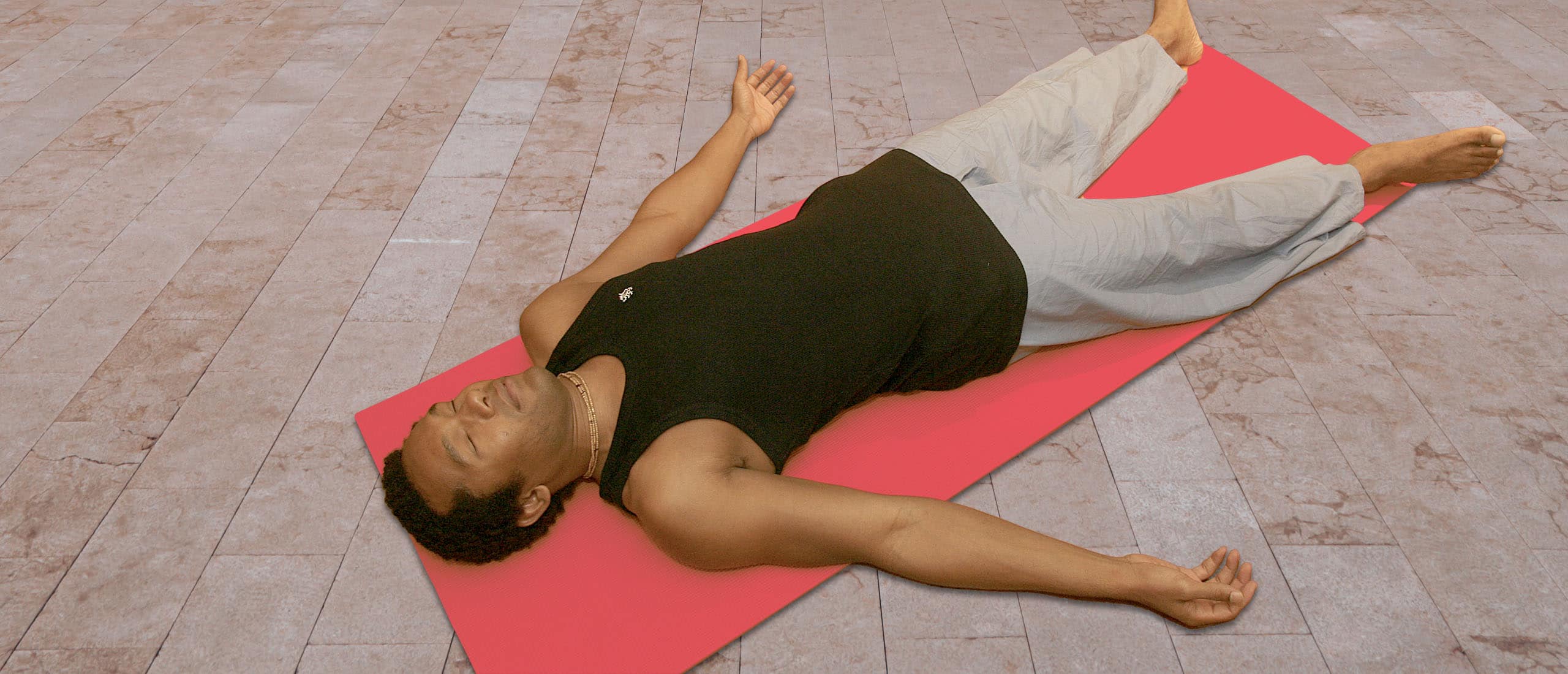NSDR (Non-Sleep Deep Rest) is as Restorative As Sleep. Here’s How to Do It
- By Janet Ungless
- Fact-checked by Tracy Middleton
- February 7, 2022
In a recent interview with The Wall Street Journal Magazine, Google and Alphabet’s CEO Sundar Pichai was asked how he handles the stress of being a Silicon Valley CEO. Does journal? Squeeze in a mid-afternoon nap? “Meditation is something I see the value of, but I struggle to do,” Pichai said. “I can relax by listening to these podcasts which are non-sleep deep rest, or NSDRs. They’re available in 10, 20, or 30 minutes, so I do that occasionally.”
Which left a lot of people wondering, what the %*&# is non-sleep deep rest? And can it make you as productive and successful as Pichai?
So What is Non-Sleep Deep Rest?
NSDR, or non-sleep deep rest, is basically just a catchy name for a centuries-old practice called yoga nidra, which means yogic sleep in Sanskrit.
NSDR is usually practiced lying down as an instructor guides you through a series of breathing exercises using long exhalations, and maybe a body scan or progressive muscle relaxation. The goal: to move into a state of conscious awareness where your body and mind are completely at rest—without actually falling asleep.
During NSDR, you may feel like you’re surfing at the edge of wakefulness. NSDR encourages a deep sense of calm and relaxation—which is why some people practice it right before bed, to ease the transition to sleep.
The long-exhale breathing “is very relaxing to your nervous system,” says Andrew Huberman, Ph.D., Stanford University neuroscientist, founder and host of the Huberman Lab podcast—and the man who coined the term non-sleep deep rest.
Huberman says he came up with the name NSDR “first because scientists love acronyms almost as much as the military does,” and second because many people who could benefit from the practice “are averse to doing anything that has a name like yoga nidra. “If they hear yoga nidra they think magic carpets,” says Huberman.
“And yet it’s such a powerful tool—a zero-cost tool that if done regularly has enormous effects,” says Huberman. It reduces stress and helps you access calm, but also increases focus and neuroplasticity — the brain’s ability to modify, change, and adapt in response to experiences.
More neuroplasticity equals an ability to learn new things way faster, according to Huberman.
Bringing yourself into a state of calm relaxation through breathing and visualization is the hallmark of yoga nidra—and NSDR, Huberman says. “Our thoughts follow our vision and breathing.” When your breathing slows, so do your racing thoughts.
He’s found non-sleep deep rest to be the one practice that has really helped reduce his stress and allowed him to control his state of mind late in the evening so he can fall asleep more easily.
“It doesn’t have to be done every day” to feel the effects, he adds. But like meditation, the more you do it, the more likely you are to reap the rewards.
Benefits of NSDR
The perks of achieving a recuperative level of rest depend on what time of day you practice.
Stress reduction, relaxation, and help falling asleep
“We generally have a hard time falling asleep because we think we have to turn off our thoughts completely like a switch,” says Huberman. Which of course we can’t.
“[During] the transition to sleep our thoughts become fragmented, we become relaxed, and the brain enters the state where space and time are very fluid and not under our conscious control,” says Huberman.
Huberman points out that work done in his lab and others shows that the state of shallow sleep achieved in NSDR can help you get better at turning off your thoughts so you can fall asleep faster when your head hits the pillow.
Recharging your batteries
Resting your brain deeply during the afternoon can recharge your batteries, sharpen focus, and prime you to take on the rest of the day feeling more energized, refreshed, and rejuvenated — as if you just took a nice long nap.
“I’m a huge proponent of rest—my latest book is titled The Rested Child for a reason,” says Dr. Chris Winter, M.D., a neurologist and sleep medicine specialist. “I strongly believe in resting and think the idea that we have to fall asleep in bed for the resting period to benefit our bodies is simply not true.”
Winter says he sometimes practices NSDR after his last patient of the morning, during his lunch break, and it re-energizes him for the second half of the day.
Faster learning, better retention
“Two papers published in the last two years, from Cell Reports and Cell Press Journal, show that a 20-minute non-sleep deep rest protocol after a bout of intense focus or attempt to learn anything — skill learning or cognitive learning — accelerates neuroplasticity by about 50 percent,” Huberman says. Essentially, you’re learning much faster, and you’re able to retain that information for longer.
Neuroplasticity is triggered by periods of intense focus, he says. “But the actual rewiring of neurons, the formation of new synapses, and the reordering of the circuitry that leads to that skill or that cognitive ability becoming reflexive happen in states of deep rest. And non-sleep deep rest, NSDR, whether it’s yoga nidra or hypnosis or a shallow nap of about 20-30 minutes, will all accelerate learning.”
The Science Behind NSDR
There’s plenty of science to show that techniques strengthening the connection between the emotional, mental, and physical—you know, mind-body practices—are helpful for lots of situations and conditions.
Whether it’s prepping for a medical procedure or managing a difficult boss, they can help you take charge of your thoughts, reframing them to calm your physical response, which then decreases anxiety. Or helps clear your head.
Clinical studies (1) have shown that yoga nidra, which works on the autonomic nervous system (the bodily processes that happen without any effort on your part, such as heartbeat, blood flow, breathing, and digestion) is associated with positive physiological changes, including improvements in red blood cell counts, blood glucose levels, and hormonal status.
Two neuroimaging studies have shown that yoga nidra triggers changes in endogenous dopamine release and cerebral blood flow, further confirming that its effects on the central nervous system are measurable.
Another study (2) showed that while meditation and yoga nidra were both great tools for reducing anxiety and stress, yoga nidra was more effective in reducing “both the cognitive and physiological symptoms of anxiety.”
Try it For Yourself
Want to give NDSR a try?
Google “yoga nidra videos” and you’ll find them all over YouTube, of varying lengths and by various instructors. Huberman likes those by Kamini Desai because he likes her voice.
Huberman himself posted his own video that guides you through a 10-minute NSDR meditation.
One we tried and really liked was this one by Liam Gillen. As we listened in bed, we found ourselves in a dreamlike, drifty state, though Gillen’s voice was crystal clear. That night, after the session, we fell into a deep restorative, 9-hour sleep, which we sorely needed.
References
1. Pandi-Perumal SR, et al (2022). The Origin and Clinical Relevance of Yoga Nidra.
2. Ferreira-Vorkapic C, et al (2018). The Impact of Yoga Nidra and Seated Meditation on the Mental Health of College Professors.














